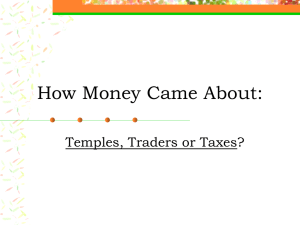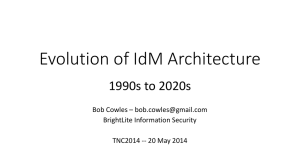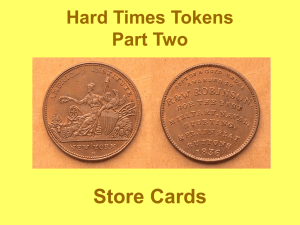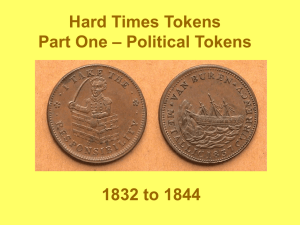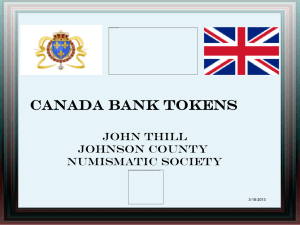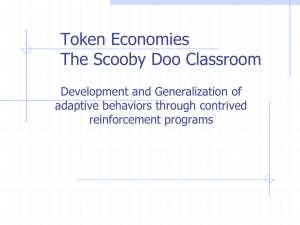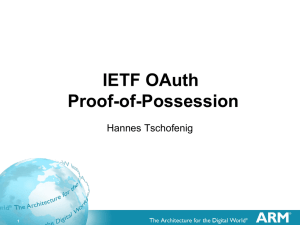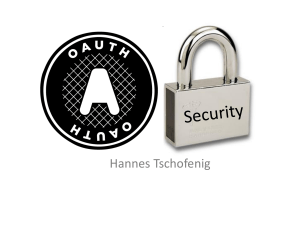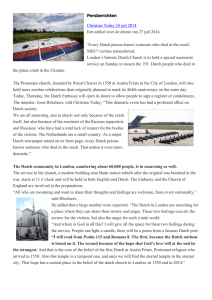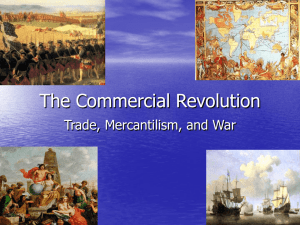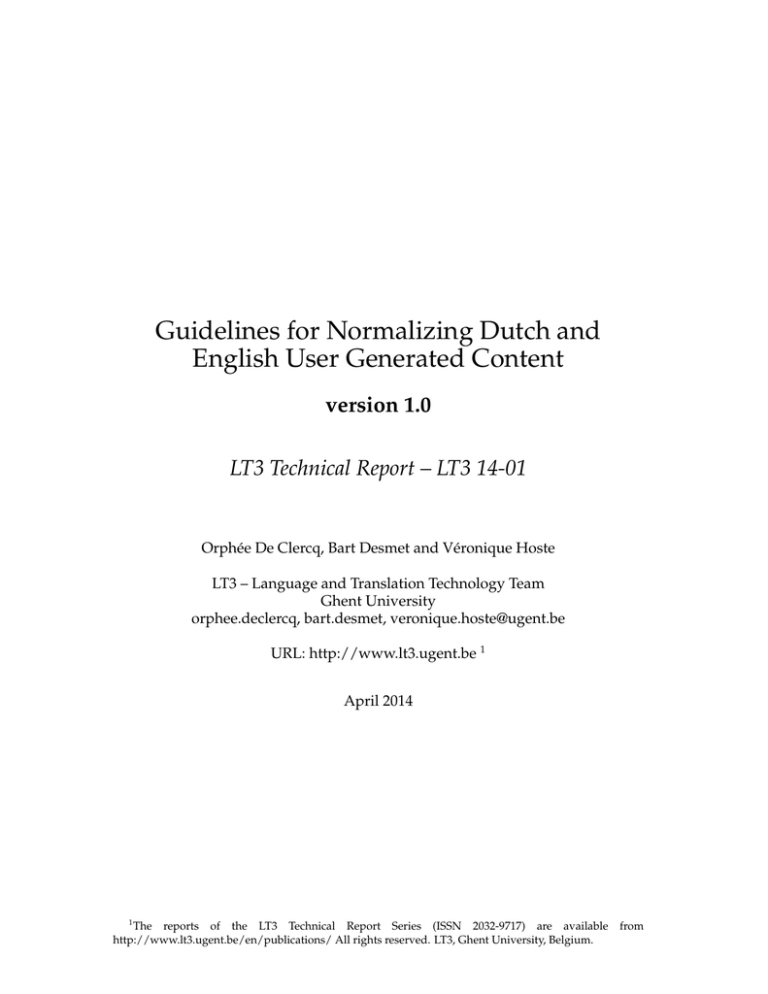
Guidelines for Normalizing Dutch and
English User Generated Content
version 1.0
LT3 Technical Report – LT3 14-01
Orph´ee De Clercq, Bart Desmet and V´eronique Hoste
LT3 – Language and Translation Technology Team
Ghent University
orphee.declercq, bart.desmet, veronique.hoste@ugent.be
URL: http://www.lt3.ugent.be 1
April 2014
1
The reports of the LT3 Technical Report Series (ISSN 2032-9717) are available
http://www.lt3.ugent.be/en/publications/ All rights reserved. LT3, Ghent University, Belgium.
from
Contents
1
2
Introduction
2
1.1
Characteristics of user generated content . . . . . . . . . . . . . . . . . . . . . . . .
2
1.2
Two-step approach . . . . . . . . . . . . . . . . . . . . . . . . . . . . . . . . . . . . .
3
1.3
Technical report . . . . . . . . . . . . . . . . . . . . . . . . . . . . . . . . . . . . . . .
3
Guidelines
4
2.1
General overview . . . . . . . . . . . . . . . . . . . . . . . . . . . . . . . . . . . . . .
4
2.2
In-depth explanation . . . . . . . . . . . . . . . . . . . . . . . . . . . . . . . . . . . .
5
2.2.1
MAIN COLUMNS . . . . . . . . . . . . . . . . . . . . . . . . . . . . . . . . .
5
2.2.2
FLAG COLUMNS . . . . . . . . . . . . . . . . . . . . . . . . . . . . . . . . .
6
Agreements . . . . . . . . . . . . . . . . . . . . . . . . . . . . . . . . . . . . . . . . .
9
2.3
1
Chapter 1
Introduction
Before training an automatic normalization system it is crucial to manually normalize noisy data
into its standard form and create a gold standard. These guidelines were developed in order to
standardize the manual normalization of Dutch and English user generated content. For Dutch,
these guidelines have been drawn up in close collaboration with the developers of the Chatty
Corpus (Kestemont et al., 2012) and for English findings from previous studies (Baron, 2003)
were included.
1.1
Characteristics of user generated content
We start by presenting some Dutch examples which clearly illustrate the main characteristics of
this genre of text in Table 1.1 below.
SMS
SNS
TWE
ORIGINAL
Oguz ! Edde me Jana gesproke ?
En ze flipt lyk omdak ghsmoord
heb .. !
schaaaat , Je komt wel boven die
Blo , je et em nii nodig wie jou
laat gaan is gwn DOM :p Iloveyouuuu hvj
@minnebelle top ! Tis voor m’n
daddy !
NORMALIZED
Oh gods ! Heb je met Jana
gesproken ? En ze flipt gelijk
omdat ik gesmoord heb ... !
schat , Je komt wel boven die
Blo , je hebt hem niet nodig wie
jou laat gaan is gewoon dom :p I
love you hou van je
@minnebelle top ! Het is voor
m’n daddy !
TRANSLATED
Oh god ! Did you speak to Jana
? And she’s flipping because I
smoked ... !
honey, You’ll get over that Blo,
you don’t need him whoever
lets you go is just stupid :p I love
you I love you
@minnebelle great ! It is for my
daddy !
Table 1.1: Examples of UGC from the three social media genres representing the original utterance, its normalized version and an English translation
These examples clearly illustrate the main characteristics of UGC. Some of the more well-known
problems include the omission of words or characters, e.g. the omission of the final n in gesproke
(Eng: spoke versus spoken). The frequent use of abbreviations and acronyms, such as gwn, hvj
(Eng: LOL), which are highly productive. Moreover, many utterances deviate from the standard
spelling at the lexical level, such as lyk instead of gelijk (Eng: luv versus love) or by writing colloquially, e.g. et em instead of hebt hem (Eng: you iz vs you are). In UGC, emotions are also expressed
by using flooding (repetition of the same character or sequence, baaaaaaby), emoticons (:p) and
capitalized letters (STUPID).
2
More specific to the Dutch language is the concatenation of tokens which leads to the elimination
of clitics and pronouns (Edde instead of Heb je, khou instead ik hou, Tis instead of Het is). Actually,
this is also quite frequent in English UGC, e.g. gimme, gonna, wannit. Moreover, the influence
of the English-speaking world on Belgium and the fact that it is a trilingual country often leads
to various languages within a single utterance, which are often adapted to Dutch aspects (Oguz,
daddy, we are forever).
1.2
Two-step approach
The guidelines can roughly be divided into two parts. The first part consists of the actual text
normalization and comprises three steps: clearing all obvious tokenization problems, stating the
different normalization operations and writing down the full normalized version. We allow four
different operations: insertions, deletions, substitutions and transpositions. Examples of tokens
requiring these operations are given below.
• INS: spoke (spoken), sis (sister)
• DEL: baaaaabyyyy (baby)
• SUB: iz (is), stoopid (stupid)
• TRANS: liek (like)
Insertions allow to indicate missing characters in a string. Deletions are used when characters
should be deleted from a certain string. Substitutions are used when a character has been replaced with another similar one. Finally, transpositions are used when a combination of characters should be switched within one string.
The second part of the guidelines consists of flagging additional information that might be useful
for further automatic processing purposes. Within each utterance the annotators were asked
to indicate the end of a thought (to account for missing punctuation), regional words, foreign
words and named entities. They could also flag words that are ungrammatical, stressed, part of
a compound, used as interjections or words that require consecutive normalization operations.
1.3
Technical report
This technical report contains guidelines to normalize Dutch and English user generated content.
The annotation and normalisation was first done in Excel and then transferred to Google Docs
so as to make it easier to share and to comment on the performed normalisations. In the remainder of this report the guidelines are discussed in closer detail while giving sufficient examples
(Chapter 2).
These elaborated guidelines would not have been possible to develop without the first Dutch
version drawn up by Master’s student Lien De Rieck.
3
Chapter 2
Guidelines
We distinguish a total of 16 standard columns. As mentioned in the Introduction the annotation
process consists of two steps: the first six columns comprise the first step and will be referred
to as the ’main columns’, whereas the remaining ten columns will be called ’flag columns’. We
will first present a general overview of all available columns (2.1) after which we zoom in on the
relevant columns (2.2)
2.1
General overview
• MAIN COLUMNS
1. ID-column: each text item receives an ID for further referral.
2. Original-column: this column contains the user generated content text in its entirety.
3. Anomalous-column: contains the original text split along whitespace. Each new row
represents a new token. Please note that words immediately followed by punctuation
or emoticons remain untouched in this column.
4. Tokenised-column: is the first proper step to normalisation. If necessary, the token
in the anomalous-column can be split. This action is used to separate two or more
characters of different origins. Hey!, for instance’ will be tokenised to Hey !. The same
holds for Jupjup!:), which will be converted into Jupjup ! :).
5. Operation-column: contains the operations needed to convert the original token into
its normalised version. These operations include deletion, insertion, substitution and
transposition.
6. Normalized-column: consists of the normalised or standardised version of the token
in the anomalous-column.
• FLAG COLUMNS
7. End of Thought-column: indicates where the ’thought’ should end (i.e. where we flag
the end), or ends (i.e. where the actual punctuation is present).
8. Regional-column: indicates whether a token is regional.
9. Foreign-column: indicates whether a token is of foreign origin.
10. Named Entity-column: indicates whether a token is a named entity.
11. Rubbish-column: is used for tokens that have no significant meaning.
4
12. Interjection-column: indicates whether the token is an interjection.
13. Ungrammatical-column: indicates whether the token is ungrammatical
14. Stressed-column: indicates whether the token is emphasized.
15. Compound-column: indicates that two or more consecutive tokens are part of a compound.
16. Multiple Normalizations-column: indicates whether more than one operation is needed
to convert the original token to its normalised version.
2.2
2.2.1
In-depth explanation
MAIN COLUMNS
An illustration of the main columns is represented in Figure 1. Since columns one, two and three
are quite self-explanatory, we will start with explaining the tokenisation column.
Figure 2.1: Dutch example illustrating the main six columns in GoogleDocs.
Tokenisation column
If necessary, the token in the anomalous-column can be split. This action is used to separate two
or more characters of different origins. With ’two or more characters of different origin’, we actually mean the combination of letters and figures, punctuation, or two or more words that can
easily be distinguished. The following example will shed light on the matter: In Klaatnogwelietsweten, the spaces have been intentionally omitted, therefore, it will be tokenised as: Klaat nog
wel iets weten. So, in this example the token Klaat is still written together since this actually constitutes a normalization problem. Please note that this does not hold for items that are written
without white spaces in standard language, such as hour notations (e.g. 4u30), date notations
(e.g. 14/11), abbreviations (e.g. aug.), etcetera.
Operation-column
We have distinguished four different operations in order to transform the original word into its
normalized version. These operations comprise: substitution, insertion, deletion and transposition (cfr. Section 1.2). The method we use for annotating normalization, is based on a minimum
5
edit distance algorithm, the Levenshtein Distance in particular, which is a commonly used approach in spelling correction. This algorithm applies the four edit operations: deletion, insertion,
substitution and transposition to calculate the difference or resemblance between two strings.
This is done by measuring the LD (i.e. Levenshtein Distance) by means of these fours operations;
deletion, insertion and substitution each have a cost of 1. Transpositions, however, have a cost of
2, as, in fact, one deletion and one insertion take place.
For each operation we have defined a different way of indicating it using symbols or tags:
• For insertions (INS) we use the # sign each time a character has to be inserted;
• For deletions (DEL) we wrap the character(s) to be removed in between tags (< del >< /del >);
• For substitutions (SUB) we wrap the character(s) to be moved in between § signs;
• For transpositions (TRANS) we wrap the characters to be transposed in between tags (< trans >< /trans>).
Please note that normalizing a word can require multiple operations, as illustrated in Figure 1,
where transforming the word snappek to snap ik necessitates both a deletion and a substitution.
Normalized-column
The Normalised-column contains the fully normalized or standardized version of the Anomalouscolumn. E.g. bdriege will become bedriegen and the normalized version of probeern will be proberen.
2.2.2
FLAG COLUMNS
For all flag columns an index system, similar to the one applied for the Chatty Corpus annotations, will be used:
• If the normalized-column contains only one token that should be flagged as, for instance,
’interjection’, a cross will be put in the interjection-column.
• If the normalized-column contains two or more tokens, a figure corresponding to the token’s place in the cell is put in the flag column.
– For instance; if the first token of a series of three is an interjection, the interjectioncolumn will contain ’1’.
– If the second token of a series of three is an interjection, the interjection-column will
contain ’2’.
– If the first and second token of a series of three tokens are interjections, the interjectioncolumn will contain ’1,2’.
End of Thought-column
Context is of utmost importance in the flagging of ends of thoughts. We have deliberately chosen
to indicate the ends of thoughts, instead of sentence endings. Annotating sentence endings does
not imply it is the end of thought. The author could, for example, end sentences with a full stop,
and add one or more emoticons. In most cases, however, the emoticon or emoticons still refer to
the previously stated sentence. Consequently, we cannot treat them as separate items. In En weet
6
ge al iets voor papa? Bel mij anders es :-) Xxx, the end of thought will be indicated on :-) and on
Xxx. An example of an End of Thought that deviates from the original punctuation can be found
in the following sentence: Nonkel pascal, vergeet je ons niet morgenvroeg om 04.00 hr? ;). Here, the
smiley will be marked End of Thought, and not the question mark.
Regional-column
Tokens will be indicated as regional if they do not occur in the Van Dale dictionary for Dutch text
and for English in the Oxford English Dictionary. If tokens do, however, occur in the dictionary,
but differ in meaning from the dictionary explanation, they will be regarded as regional as well.
subiet, for example, can be found in the Van Dale dictionary and means immediately. In regional
language, subiet and its variants have a different meaning, i.e. in a while, later. cava, cva, etc. are
also considered as regional, even though they are of foreign origin. The reason behind this is also
the change in meaning.
Regional tokens will be normalized to their stem, *uufflakke, for instance, becomes hoofdvlakke
and not kopvlees. To check the stem of regional tokens, following website will be used for Dutch:
http://www.vlaamswoordenboek.be/ and http://www.urbandictionary.com/ for English.
Foreign-column
Tokens will be marked as foreign if they are of foreign origin and if the token’s meaning was
preserved in the target language. For Dutch, in most cases, the foreign tokens are of French or
English origin whereas in (especially American) English many Spanish words occur. The foreign
words will not be tokenized nor normalized, with the exception of flooding (i.e. the superfluous
occurrence of one single character, such as in mamaaaa, beeeeel!!! and omgggg) , abbreviations and
spelling. Dutchification of foreign words, too, will be indicated as foreign. Examples belonging
to this category are merci, thx, seriously and the Dutchified nicezen as in me myne nicezen t-shirt van
avril sie xd.
Named Entity-column
Names and surnames, brand names, towns and cities, names of services (varying from mobile
phone providers Proximus, Mobistar,... to railway services NMBS) will all be flagged as named entities. Abbreviations or names referring to particular courses at school, etc. will not be considered
as named entities, but as Rubbish (see next section).
Rubbish-column
Tokens flagged as rubbish comprise abbreviations of particular school courses and references or
abbreviations limited to the work environment, information that has clearly not been written by
the author of the message (e.g. citations) and items that cannot be understood without more
context. Redundant repetitions of words, too, will be flagged in the Rubbish-column. In, for
instance, Dat meisje meisje daar, the second occurrence of meisje will be fully deleted and subsequently flagged as Rubbish.
7
Interjection-column
The following items are marked as interjections:
• conversational initialisms and endings, with the exception of vocative use of (proper) nouns
(grtz, hi, x, yo,...)
• emoticons (=p, :), :p, xp, xd,...)
• common internet abbreviations such as btw, lol, fb,...
• dialectical intensifiers such as ze, hoor, he, wa, maat, etc in Dutch.
• words that represent an expression, often onomatopoeia (zucht, pff, ...)
• words in between brackets
• small words such as ja/yes, nee/no without context.
Ungrammatical-column
The category of ungrammatical items is ample and comprises, amongst others, the omission of
the subject, the main verb, or the combination of both subject and verb. Examples of these kinds
of omissions are: *Ø Heb het vernomen., ’*Ø Toevallig geen tijd/ zin om iets te drinken?. Note that the
vocational use of language is not considered as ungrammatical. In many cases, other constituents
of the sentence have been dropped, for instance, articles, pronouns and prepositions. E.g. *ksit
in Ø cinema. and *Is dat danØ 12 november da feestje voor u mama?. All ellipses will be flagged as
Ungrammatical in the row that follows the ellipses. Occasionally, there are too many words in
one sentence, for example double negation. These, too, will be flagged as Ungrammatical.
Stressed-column
Tokens that are emphasized will be normalized to their standard form. For example, ge-weldig
and m´et - as opposed to zonder- will be normalized as geweldig and met respectively. Subsequently,
both will be flagged as stressed. Various instances of flooding of words and of punctuation, such
as maamaaaaa, which is normalized to mama, also belong in this category.
Compound-column
Separate tokens that are actually parts of compounds will be flagged as compounds. Note that
this does not hold for Named Entities. paard and rijden in Ik ga gn paard rijden will both receive a
Compound flag, whereas la rocca as in Lynn ga ni mee & cc, noxx, la rocca & carr blijve ng over. will
not be flagged as such.
Multiple Normalizations-column
Some tokens need to be normalized in two separate steps. Instances such as looool and btwww
will be marked as Multiple Normalizations and normalized to laughing out loud and by the way. The
operations column should contain the normalization of both steps. In the case of looool this will
be: l#######< del> oooo < /del > o## l### .
8
2.3
Agreements
Following items have been agreed upon:1
• Capital letters will only be preserved if they appear in the original message. When the
anomalous token indicating sentence beginning contains a capital letter that is not in its
right place in the normalized-column, the first letter of that sentence will be capitalized
nevertheless. Following example will clarify this rather abstract description:
• Whitespaces are not insertions
• Use of regional language will be preserved ge, for example, will not be normalized to je.
Verbs, too, will retain their dialectical form. Ge wilt will be flagged as regional but will not
be standardized.
• A token can contain different substitutions if there is phonemic correspondence between
the anomalous form and the standardized version. Boejemie will therefore be written in the
operations-column as Boejemi¡del¿e¡/del¿ and normalized to Buscemi.
References
Baron, Naomi S. 2003. Language of the internet. The Stanford Handbook for Language Engineers,
pages 59–127.
Kestemont, Mike, Claudia Peersman, Benny De Decker, Guy De Pauw, Kim Luyckx, Roser
Morante, Frederik Vaassen, Janneke van de Loo, and Walter Daelemans. 2012. The netlog corpus.
a resource for the study of flemish dutch internet language. In Proceedings of the Eight International
Conference on Language Resources and Evaluation (LREC’12), Istanbul, Turkey, may.
1 This
section should keep on growing in the next versions of this report.
9


